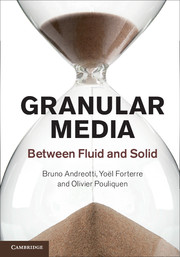9 - Geomorphology
Published online by Cambridge University Press: 05 June 2013
Summary
Sand dunes, screes, river deltas … Most geological structures at the Earth's surface involve granular materials. This final chapter proposes an application of the various properties of granular media developed throughout this book to geomorphology, i.e. to the study of the nature and origin of landforms, particularly regarding the formative processes of weathering and erosion that occur in the atmosphere and hydrosphere. These processes continually shape the Earth's surface, and generate the sediments that circulate in the rock cycle. Landforms are the result of the interactions among the geosphere, atmosphere and hydrosphere.
On the one hand, we will propose a description of sedimentary landscape elements that is based on natural history. On the other hand, we will analyse various sedimentary structures in terms of physical mechanisms. When possible, we will detail the associated scaling laws, which allow one to reproduce geophysical phenomena in the lab, at small scale, in a controlled way. In particular, we have established in the previous chapter a description of erosion and sediment transport in a homogeneous flow. We will now use these results by considering the coupling between relief and transport. We will pay special attention to linear instabilities, which can explain the emergence and organization of geological objects. We will study successively gravity-driven flows (Section 9.1), ripples and dunes (Section 9.2), coastal instability (Section 9.3) and, finally, rivers (Section 9.4).
- Type
- Chapter
- Information
- Granular MediaBetween Fluid and Solid, pp. 363 - 431Publisher: Cambridge University PressPrint publication year: 2013
- 1
- Cited by

